Text
💬 Onomatopoeic/Mimetic Vocab List 💬
A few of my favourite onomatopoeic words! I might make a part 2 at some point? Please feel free to correct any errors! ♡

うらうら…gently and clearly shining
オロオロ…flustered bewilderment
くんくん…sniffing, especially a dog
ケロケロ…ribbit sound
ごろごろ…purring sound, or idleness
さやさや…soft rustling sound
さばさば…relieved, refreshed or easy going
しとしと…light rain or drizzle
すやすや…sleeping peacefully or soundly
そっと…softly, gently
ちびちび…little by little
ちんまり…snugly, cosily
ほんわか…warm, cosy, pleasant
テコテコ…the sound of walking
なんたらかんたら…something or other, “what do you call it?”
ふわふわ…soft, fluffy
ムギュウ…squeezing, hugging
メロメロ…madly in love or falling down drunk
もぐもぐ…chewing food, similar to “nom nom”
もじもじ…bashfully
りんりん…bell ringing or chiming
わくわく…trembling, nervousness or excitement
にゃん…meow
わんわん…woof
1K notes
·
View notes
Note
YOUR BLOG IS AMAZING
HEY THANK YOU SO MUCH!!!! :D
3 notes
·
View notes
Note
I hope you have a great day (o´ω`o) 💖💖
Oh wow oh wow this is so incredibly kind!!!! Thank you!!!! Thank you so much!!!
6 notes
·
View notes
Text
Looking for new langblrs to follow!
Please reblog this if you are a langblr that is studying/post about any of these languages:
Finnish
Japanese
Swedish
German
Hungarian
Arabic
… and I will check your blog out! Thank you! ♥
171 notes
·
View notes
Photo


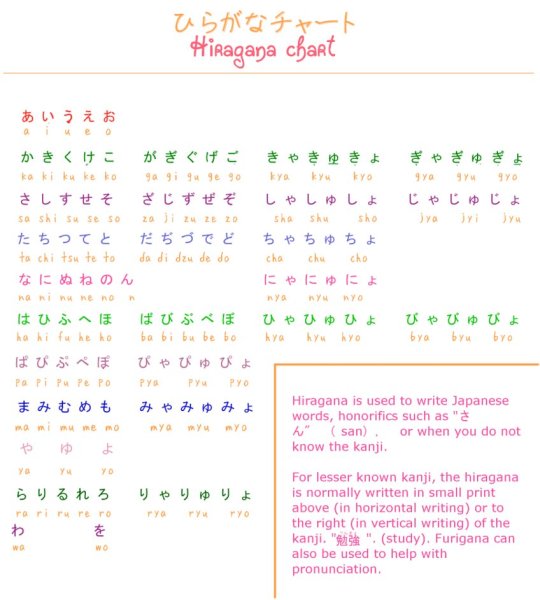



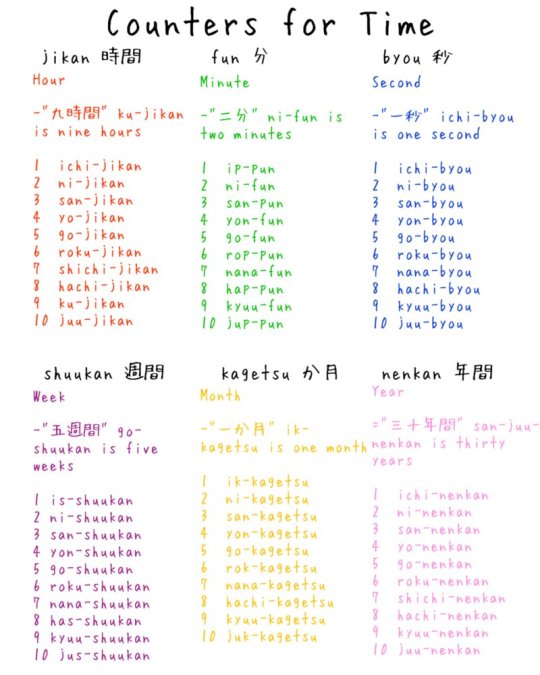



Learning Japanese cheat sheets
Source: misshoneyvanity on deviantART
http://misshoneyvanity.deviantart.com/gallery/
60K notes
·
View notes
Text
Welcome to the langblr community!!!! 😊 You've been studying it for so long wow, good luck for passing the N2!! Also tourism? That's honestly so cool! 😮
New studyblr (?)
Hi!
I wanted to start a studyblr long time ago, so here I am
Name: Yesy (her/she)
Nickname: Yoite :) (main: @yoite-arimura)
Country: Mexico
Native language: Spanish
Target languages: Japanese and English (feel free to telling me my mistakes please)
Age: 26 (birthday: Nov 12)
I studied Tourism (graduated 3 years ago)
I’ve been stuying english since middle school, bui I still feel there are many things I need to learn hehe
I’ve been studying japanese since almost six years ago, but (same as english) there are many things that I don’t really know how I learned them… there are sooo many blank spaces, so i decided to start this blog in order to keep me motivated to do some self study, while I take courage to go back with my japanese teacher.
Blogs that inspired me: @strawblondiestudies @mochiilang @iroiroo @japanesestudyblr @atejapan @intellectys @uni-venture
よろしくね! (^O^)/
More about me:
Keep reading
53 notes
·
View notes
Photo

soomin_jeon
#so pretty#fuji-san#i dont call it mount fuji anymore...just fuji-san from years of watching anime...#photography
692 notes
·
View notes
Link
If you like anime/manga then Gigguk creates literally the best videos-- like this one!
OII GUYS!!!!
I am cracking up here oh deaR GOD.. That made my shitty exam day level up to top 😂😂
PLEASE WATCH THIS 🤣🤣🤣
20 notes
·
View notes
Note
Sorry if you’ve gotten this question before but what do you recommend for practicing writing characters? Like paper and pens? I’ve tried practicing on regular paper but I feel like it doesn’t help with getting the characters to look right and was wondering if there’s better ways to practice?
don’t worry! i haven’t gotten this exact question so it’s all good! also, writing characters is one of my favorite ways to learn them so i could answer questions about this all day
i do prefer practicing on paper with a pen (i say pen bc pencils usually smudge and just make things messy later on). i usually just grab whatever paper is nearby and use that, so most of the time it’s looseleaf.
if you’re worried about your characters looking right (by which i’m assuming you mean proportional and natural) then i do have a recommendation for you. you’ll need access to a printer though for this one.
in a recent ask i mention hanzi grids as a way to practice writing characters, so i’m going to bring that recommendation back and add on to it a little bit.
once you make your free account (you really just need an email address to do this) and go to make your grids, here’s what i recommend you do.
at the top of the page there will be a box labeled “content” that will look like this:

as you can see i have the phrase “你好嗎” typed into the box with the option “single characters selected” on the drop down menu. what you would do is type or paste the words you want to practice into this box.
next you should go to the sidebar and look at these options:

“visible characters” makes the grids look like this:

“opacity” just toggles how dark the gray is for the lighter characters. you can also toggle the “visible characters” option to show less of the characters so you can practice on your own so it would look something like this:

once you’ve set the grids up to your liking, you just hit the button that says “generate pdf” and then print it. once you’ve got that, just practice writing until you’re satisfied!
i really hope this was what you were looking for! 加油!
2K notes
·
View notes
Text
This vlog made me feel like I was in Japan!! So good! (≧◡≦)
akihabara x harajuku vlog✿
hello everyone (´ ˘ `∗)
i have uploaded a new vlog about a weekend i spent in harajuku and akihabara, and it would really mean a lot if you could watch it! i think i’ve been overthinking the whole social media thing too much and so this time around, i decided to let go a little and have some fun in the video (´。• ω •。`) i hope my personality shows a little more in the vlog, and that you enjoyed watching it! go watch it here→ https://youtu.be/TV0vxDfwE3I
let me know what you think in the comments °˖✧◝(⁰▿⁰)◜✧˖°
as well, i have opened up a new instagram account! i’ve never posted my own photos on this blog but i want to share my life with you all, so i’ve decided to use instagram as a way of doing that. follow me here→ caromelette
reply to this post with your instagram name if you’ve followed me and i’ll give your posts some love (✿´ ꒳ ` )♡
finally, i wanted to let you all know that i have a twitter account. this is where i’m most active as i often tweet about my day-to-day, so if you’re interested you can follow me here→ caromelette
thank you so much for reading ❀.(*´◡`*)❀. have a wonderful day!
vlog channel | twitter | instagram
please subscribe + follow if possible ₊(ˊᵕ͙ૣᴗᵕ͙ૣˋ)ˈ·˚* your support really means the world to me !!
20 notes
·
View notes
Text
Studying with Manga (my method, anyway)

I only just recently started using manga as a study tool because honestly, it’s intimidating to crack open a book and realize just how little you actually know. I wish someone had told me earlier that it doesn’t have to be a terrifying jumble of grammar and kanji I haven’t learned yet, because it’s been a great tool! So I wanted to write a little guide for people who aren’t sure where to start, hopefully this helps someone!
Knowledge you’ll need: Ability to read hiragana & katakana, mid-beginner level grammar and vocab (if you find yourself struggling with every single speech bubble, maybe come back to this method later)
Some benefits to studying with manga:
★ You’ll get exposure to more casual and natural text than what you might find in a textbook
★ You’ll pick up a lot of genre-specific vocab
★ Illustrations make it easier to follow what’s going on based on context if you’re not quite sure about the text
★ It’s fun! And you absorb information better when you’re enjoying yourself :)
And some cons:
★ Speech might be more colloquial than you really want. Make sure you understand the context before you go repeating the dialogue
★ Said genre-specific vocab might not actually be useful, depending on the genre (I know SO MANY yu-gi-oh related words that I am NEVER going to need…)
★ Manga doesn’t care where you are in your textbook, so it’s on you to figure out the things you haven’t learned yet
Picking out a series
The main points to look for is that the language is relatively simple, the kanji has furigana attached and the genre is relevant to you (both because it won’t be very interesting otherwise, and because you’ll be picking up vocab as you go and it’s more useful if it’s vocab you can use in life). Yotsuba&!, Chi’s Sweet Home and Nichijou are some good examples. They can be purchased pretty easily on Amazon.co.jp for about $6 a volume. If you’re impatient it’s not particularly hard to find raw scans online, but please support the artist by buying the manga too :)
Let’s study!
I like to take it one chapter at a time and read each chapter 3-4 times, focusing on different things each time
First read: simply read through the chapter straight through- take your time to understand what you can and make notes of the pages where there’s something you’re unfamiliar with as you come across them, but don’t get hung up on them.
Second read: Go back to the trouble pages and look up any vocab and kanji you don’t know. Write them down along with their translation (if you do flashcards, add them to your deck for later review too!)
Third read: Go through one more time with your newfound vocab knowledge and see how much you can get this time. Look up any grammar you’re struggling with as you go along. Also, take any sentences you understand but had trouble with and add them to your flashcards as well (why & how you should study full sentences via flashcards)
Fourth read: if you have access to the English version of the manga, go through and compare your understanding to the official translation, see if you were wildly off anywhere and figure out why.
Go through each chapter like this and by the end of one volume you should have a ton of kanji and vocab to study, as well as a better understanding of how certain phrases are used and possibly some new grammar points! Neat! And hopefully you had a good time doing it, too :) this is a great way to make studying feel like less of a slog and break yourself out of you textbook comfort zone.
321 notes
·
View notes
Text
I love japanese bc it’s so regular and logical. eg,
kore = this, sore = that, dore = which
koko = here, soko = there, doko = where
koitsu = this person, soitsu = that person, doitsu = germany
174K notes
·
View notes
Link

The curious case of Particle WA and GA
This is one of the most frequently asked questions to people who just started learn Japanese.
What this article is about
We assume that reader have cover basic usage of WA & GA. So in this article, we will be talking about common cases (complete with thorough explanations) in which particle GA and WA seems as if it is interchangeable but have a subtle difference in meaning.
Also common cases in which particle が is recommended for some word (such as suki / hoshii) but then we found that someone use は but it turns out to be correct anyway, which might confuse you.
Here’s some of them below. Read the complete article by clicking the link above!
Case & Explanations : When Particle WA and GA seems interchangeable
1. Subtle difference when used in Questions
By using the GA format, the focus is in WHICH PERSON, by using WA format, the focus of questions is in ABOUT SAKURA. To properly reply the questions, we use the same particle.

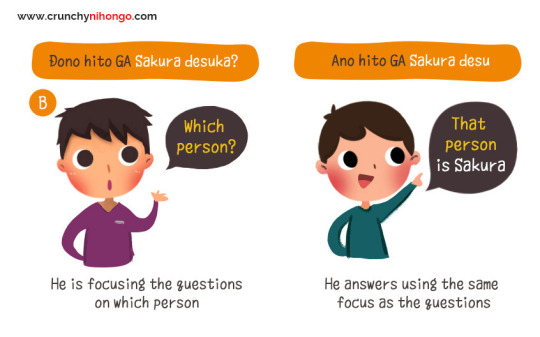
2. Subtle difference in meaning
Within the sample below, by using WA, the sentence scope is Little girls in general. Because you are saying “About little girls… They are very cute”
While with GA, you specifically mention only one little girl whom you might think is very cute. Literally “The little girl is very cute”
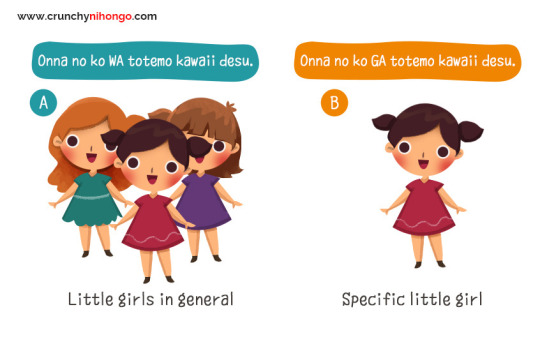
So the difference in here can be seen in the scope. In more cases, the difference in meaning can be in other things but the logic is still the same. For example: … hazu WA nai and … hazu GA nai.
The first one means THERE IS NO EXPECTATION (as in no way! Impossible!) while the second means NOT EXPECTED (as in I don’t expect him to be so smart).
3. Difference in focus of sentences
By using WA, the focus is on describing John. About John, As for John… As you can see below, with WA the block is quite flexible. The literal meaning is About John… (description)
But by using GA, the focus is in the whole set of John GA sakana wo tabeteimasu. The sentence is fixed as in English sentence of Subject-Verb-Object of John is eating fish.
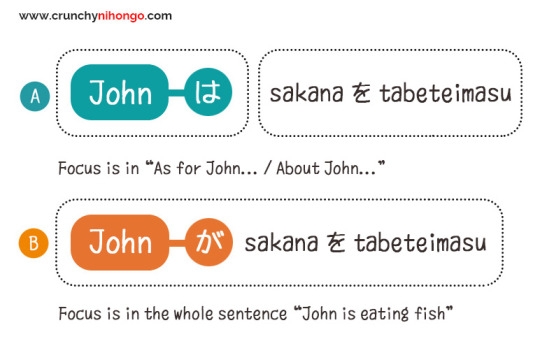
4. Implying there are something else other than what being mentioned vs direct claim to someone/something
By using GA, the speaker only say that John is bad. But using WA, he said that “About John, he is bad…”. The WA might be use to compare more than one topic, in this case, the one who the speaker thought is bad. Therefore there might be indication that John might not the only one.

5. Used for comparison vs stating a fact
In A, the usage of は might be to compare more than one topics. In that case, the usage of は with suki is acceptable.
The full phrase might be like this “Banana WA suki janai desu ga, Tokyo Banana WA suki desu.” Which literally means: “About banana, I don’t like it, but about Tokyo Banana, I like it!”
While in B, it’s just means “Tokyo Banana is something I like.”
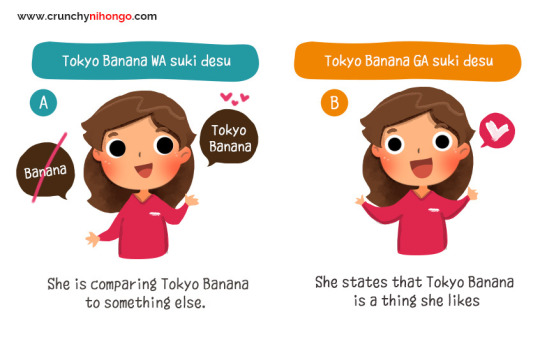
The complete explanations can be read in the article simply by clicking the link above on this post. We also review about cases when WA and GA is seen in the same sentence or WA and WA. So be sure to check it out! :D
…………………………………………
In addition of Easy Japanese lessons being updated, Japanese FAQ will cover common questions being asked in Japanese such as how to differentiate WA & GA or why sometimes は is read as WA.
If you find any typo/error or would like to send comments/feedbacks, please never hesitate to sent us message! We would love to hear from you!
Happy learning!!
。゚✶ฺ.ヽ(*´∀`*)ノ.✶゚ฺ。
2K notes
·
View notes
Audio
pssst please listen to this clip of Todoroki’s va (Kaji Yuki) singing Part of Your World, you will not be disappointed
#bnha#i just had to reblog this because it's good for japanese listening practice but#i also love todoroki and kaji yuki so???#audio
4K notes
·
View notes
Photo

there’s a japanese handwriting tag going around studygram right now and i had the honor of being tagged in it!! i’m also really digging pink right now! i challenge anyone else who wants to do this tag! it was a lot of fun and helped me refresh some of the katakana i’ve forgotten i need remembering
93 notes
·
View notes
Text
How To Learn Multiple Languages At Once, A Masterpost
I’ve shared posts on this topic before, but I feel I need to touch on it again with my own words, especially right now. I’ve been re-organizing my language learning schedule and strategies, since my school schedule will be calming down on the 17th, my last day of the school year until August. Currently, I’m learning French, German, Spanish and Japanese.
A lot of people, even in the polyglot community, think that learning multiple languages at once is impractical, a bad idea, impossible, or all three. This depends on who you are, your learning propensities, and your schedule. If you have a lot of work all the time, it’s not a good idea to be trying this. I was working on papers, presentations, and extracurricular activities, so I concentrated on French, because I was preparing for my final exam. This is because it was difficult for me to balance four languages and all my schoolwork, and so I prioritized. This is the key to learning multiple languages. When you’re thinking about how to organize your multiple-language learning, ask yourself these 3 questions:
How important are these languages to me (in descending order)?
How much time (per week) can I commit to studying?
Do I have decent access to resources for these languages?
The first two are fairly self-explanatory, but the last one may confuse some people. This question is important, because you don’t want to be spending a lot of time looking for resources. You should make sure you have organized your materials before hand. Know what you’re using to study, and you’ll streamline your learning!
For example, I use Anki and Memrise for my vocabulary learning for all my languages, since I can usually find a decent set of vocabulary cards. For grammar, I locate a reliable and accessible grammar site or book to read from. Always keep your sources consistent, because even if you might learn something wrong, you can easily find where you wrong. The thing is: you should also cross-reference! Make sure that multiple sites or books on grammar say the same thing about certain principles, especially the ones that confuse you. I have some three or four different resources for German, and I always cross-reference if something stumps me. For some languages, I know there aren’t that many resources. For Indian languages and many minority languages, it can somewhat to very difficult to find decent resources. The Langblr community is a great place to ask about finding decent resources! Just ask us! If we don’t know, we will still post your ask with something like “ I’m sorry I don’t know but maybe one of my followers knows?”
Wikipedia is always an OK start to reading about grammar, but I warn you that Wikipedia is not only subject to change, but also can be very academic and not suited to the purposes of the language learner. I, myself, am an aspiring academic, so it’s a little easier for me, but I highly recommend finding sites written by and for language learners, like this blog! I try to write explanations in the most down-to-earth way possible, even though I still believe in using the technical grammatical terms, like “conjugation” and “case declension”, because they’re convenient and acceptable ways to describe the way a language works.
Another key part of learning more than one language at once is what I call the “degrees of separation”. What this means are the ways you separate each language. A really basic one might be already be present: the languages are different structurally and historically. With exclusion to French and Spanish, as they are both Romantic languages, German and Japanese are all from different language families. Sure, Japanese has a whole alphabet for borrowed words, but has very little in common with French or Spanish. In contrast, English borrows some of its words from other languages. Similarly, Korean has borrowed quite a few words from Classical Chinese, but shares very little in common with Mandarin otherwise. There’s also temporal separation, where you study different languages at different times or on different days.
You can also use methodical separation, using different methods or programs to study (ex. using Memrise for French and German; Japanese and Spanish on Anki). The only other one I could think of is spatial separation, where you physically study in different places for each language. Which I plan to do once I get a routine down.
If you have any questions, feel free to ask!
My first Masterpost…cool :3
229 notes
·
View notes
